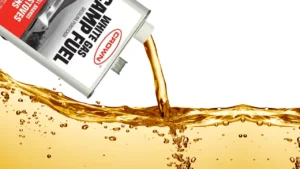I usually do a fair bit of hiking to build up a sweat when I go camping, and the last thing I want to come back to is a wet, swampy sleeping bag.
There aren’t many things that can ruin a camping trip, but trying to sleep in a damp bed can be pretty icky. Luckily, there are a few measures you can take to prevent moisture from building up in your bedding while camping.
The best ways to keep bedding dry when camping include:
- Choosing a quality tent (3-season) that is large enough so that your bedding does not touch the walls. Also, consider the quality of the shell/rainfly and if the seams are sealed.
- Choose your campsite carefully; you don’t want to be in a wide-open area where nature will hit your tent hard, but you also don’t want to be in a lower area where water will run off too.
- Setting up items like a groundsheet, camping cot, and sleeping pad can all help to keep your bedding dry at night (and make sure not to set up bedding until then).
One of the biggest reasons why bedding will get wet while camping is due to the overall moisture buildup within your tent. Over time this moisture seeps into your sleeping bag, leaving that damp and gross feel.
Thankfully there are many different things you can do to counter this effect, and for the best results, you’ll need to combine as many of the methods listed below as possible.
1. Choose a Good Tent
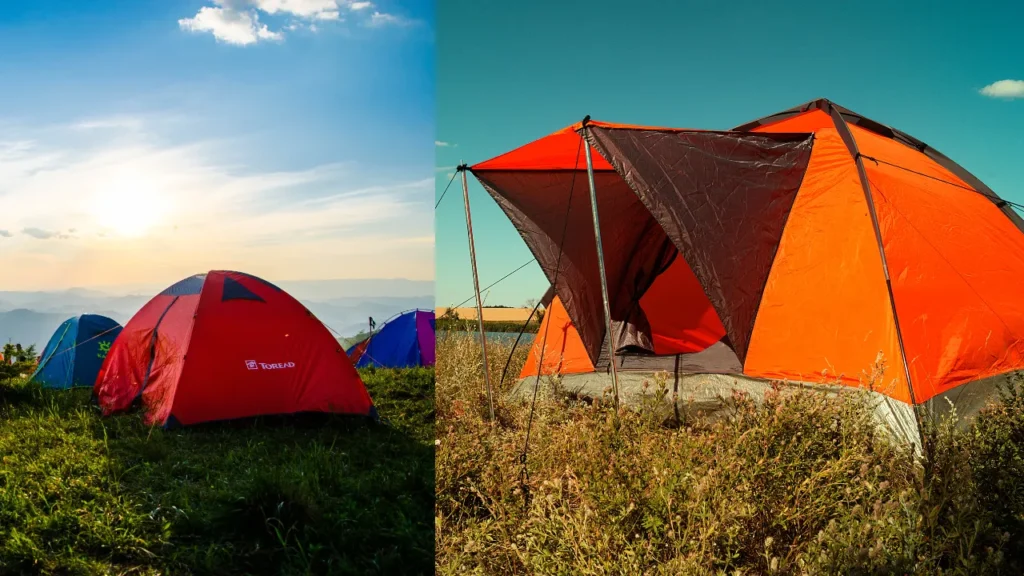
Choosing a durable tent is one of the most crucial things you can do to keep your bedding dry while camping.
The most popular choice for regular campers like myself is a two-walled tent. These have waterproof shells that will protect your tent from the elements, while still allowing you to have some airflow inside.
They are also designed so condensation passed through the inner walls of the tent and condenses on the outer wall of the tent. This helps keep your bedding and everything else in your tent as dry as possible.
Upgrading to one of these hardy tents will be one of the best things you can do to keep things dry inside, especially if you’re camping frequently.
For a tent in the $100 range, you’ll get a rainfly cover and a waterproof floor, so it’ll be a major help in keeping moisture out. The more expensive the tent goes the better the waterproofing can be.
2. Carefully Choose your Campsite
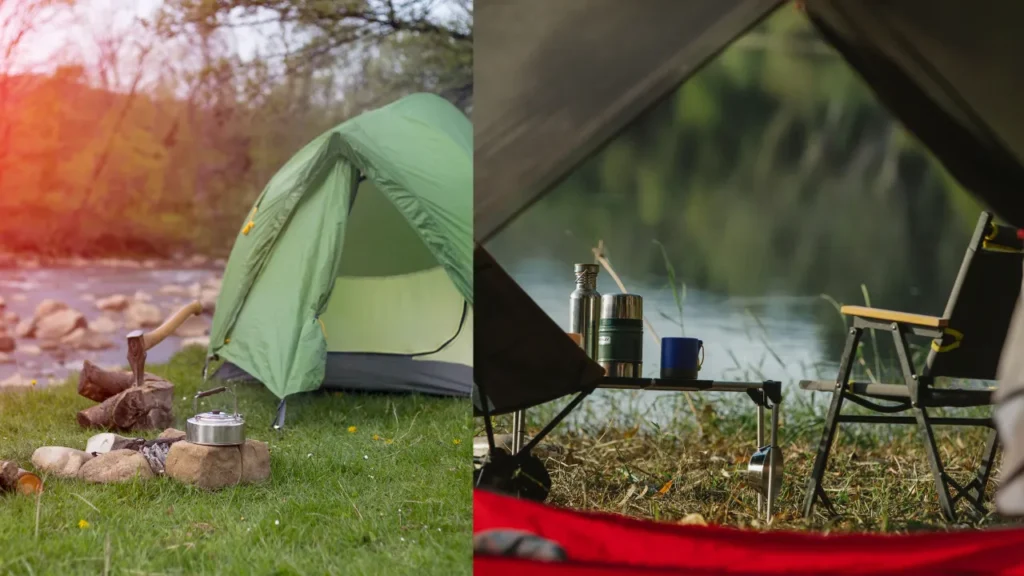
Depending on the area your camping in, choosing a smart campsite is crucial for keeping bedding dry.
Once I camped with a partner and our particular campsite flooded during the night when it rained, but other campsites were completely dry.
You’ll want to position yourself somewhere that will protect you from the elements while keeping clear of water runoff.
Plopping yourself in an open area is pretty much asking to get hit full-on by nature’s elements, and if you choose a lower area you may end up swamped with water runoff and more moisture in general.
Generally speaking low lying areas and areas close to rivers and lakes (whilst lovely) will have more humidity in the air and thus your bedding and the inside of your tent will be more likely to get wet just from the humidity in the air.
For these reasons, the best place you can find yourself is an elevated area near trees (preferably off-trail if you are worried about uninvited guests). This will ensure that you stay away from moisture while having surroundings to act as a barrier from rain.
3. Cover Your Tent Above and Below (Tarp, Groundsheet)
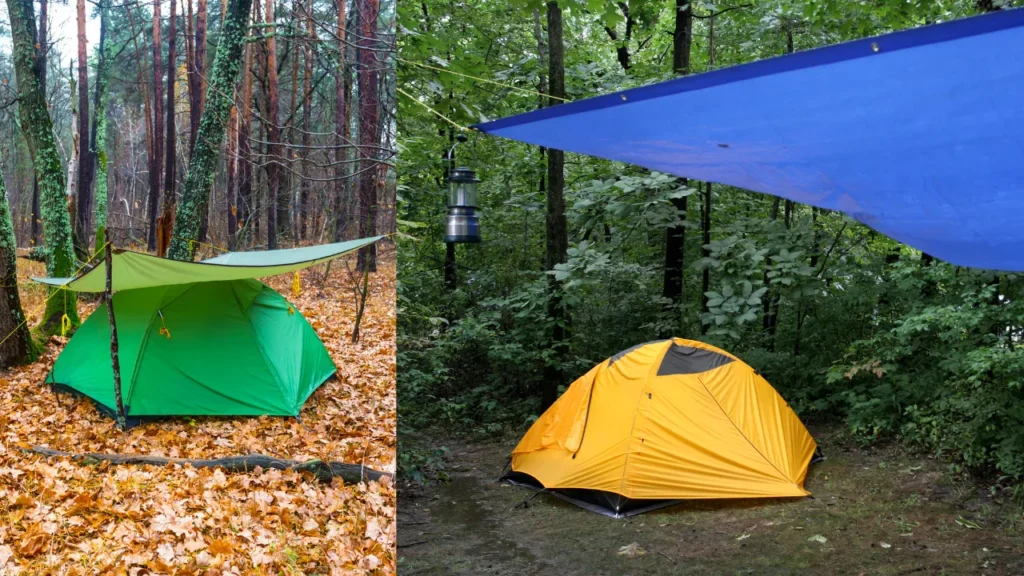
Covering your tent with a tarp and laying a groundsheet below will all but guarantee that nothing leaks into your tent, especially if you have some sort of shell on the tent already.
There are a couple of ways you can go about covering the tent. Stringing a tarp up with trees can be one of the easiest methods, but I recommend picking up some tarp poles if you aren’t in the right space for that.
Using these you’ll simply prop up the tarp on the end covering your door, and stake down the remaining edges of the tarp surrounding your tent.
Laying the groundsheet beforehand is also a good idea. While many tents provide some sort of waterproofing on the floor material, it won’t always be enough, so having some sort of layer like a tarp underneath can provide extra waterproofing (and don’t be afraid to layer it up).
It can also be a good idea to have a larger ground sheet that extends out of the door of your tent so you aren't stepping right into a puddle when you get out of your tent.
I also always recommend making sure that the seams of your tent are covered. While most modern tents already come with sealed seams, if yours are not sealed they are pretty much guaranteed to leak if it rains.
4. Keep Your Bedding Away From The Tent Entrance
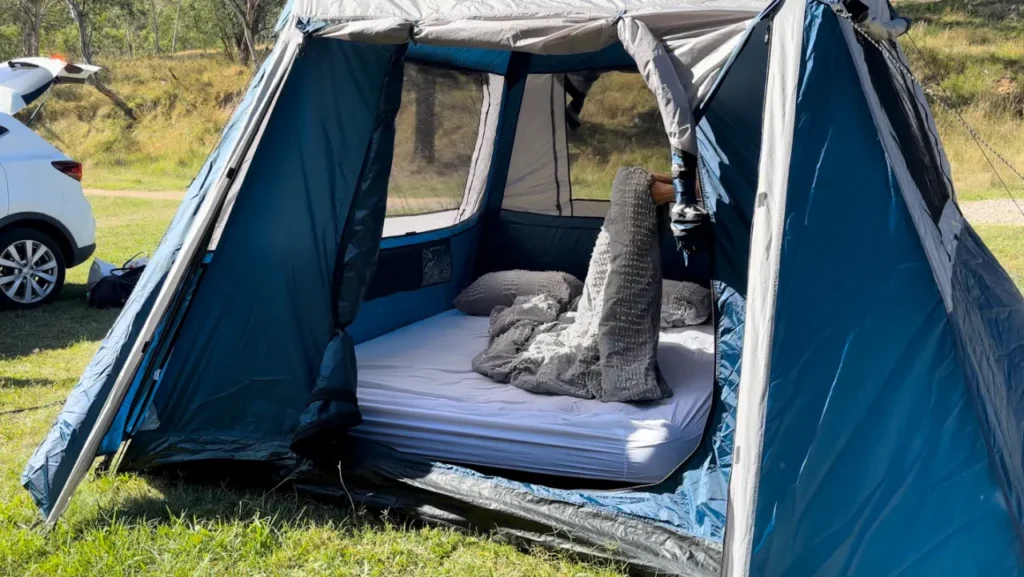
One of the main areas that water will leak into your tent and wet your bedding is through the entrance.
When the entrance is opened and people move in and out of the tent water tends to come off the exterior fly and pool on the floor of the tent.
Water can also shake onto your bedding or be absorbed into your bedding through the floor.
Try to keep the base of your bed away from the entrance to your tent when it's raining.
5. Don't Let Your Bed Touch The Walls Of Your Tent
I remember camping in a small 2 man person tent during a rain storm. Me and my partner used a queen size matress that was slightly too large for the tent and touched the walls.
What happened was our bedding absorbed water through the walls of our cheap little tent and became absolutely soaked on the sides.
Always do your best to make sure your bedding is not touching the sides of your tent.
Whether it's raining or not each person expires around 1 liter of water in the night and this often condenses on the inside walls of your tent and can be absorbed into your bedding it it's touching the walls.
6. Stop Tent Condensation
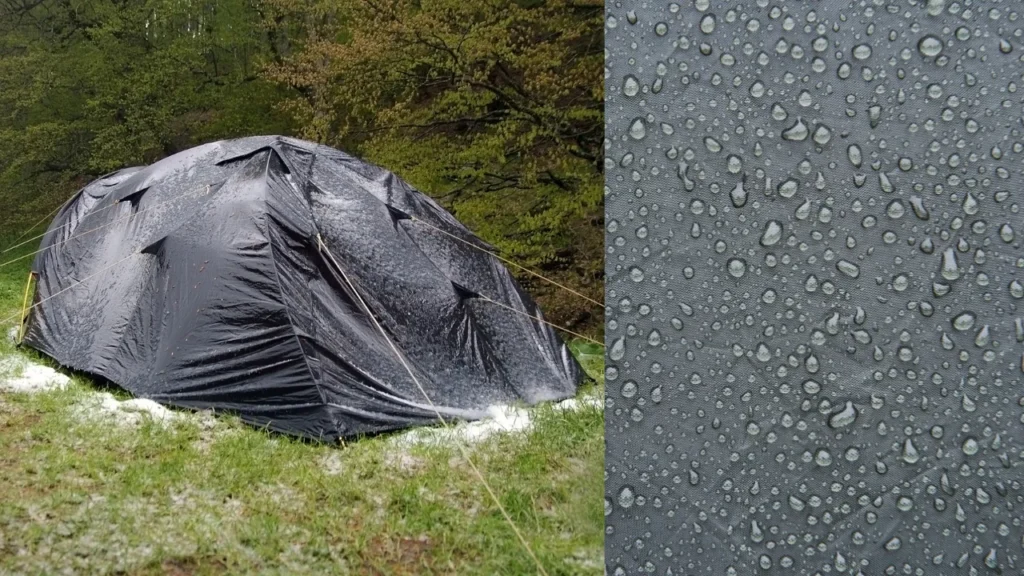
We've all experienced waking up in the morning and touching the walls of our tent and the walls are wet.
It's even worse when they are so wet that a downpour of water droplets falls onto you.
Each night, each person expires around 1 liter of water through their breath and sweat. If your tent isn't opened up then this will all condense on the walls of your tent.
Opening the fly or windows during the evening can help to minimize this condensation. Obviously if it's raining this can be difficult to do, but this is why a separate tarp over your tent can be so valuable.
Not only does it stop rain coming it but it allows you to leave your tent windows or fly open so water vapor to leave your tent and not condense on the walls, wetting your bedding.
You can also get a tent dehumidifier to help remove moisture from the air throughout the night and this too can help to keep everything dry. Click here to see the best tent humidifiers available or click here to see some DIY tent humidifier options.
7. Re-Waterproof Your Tent
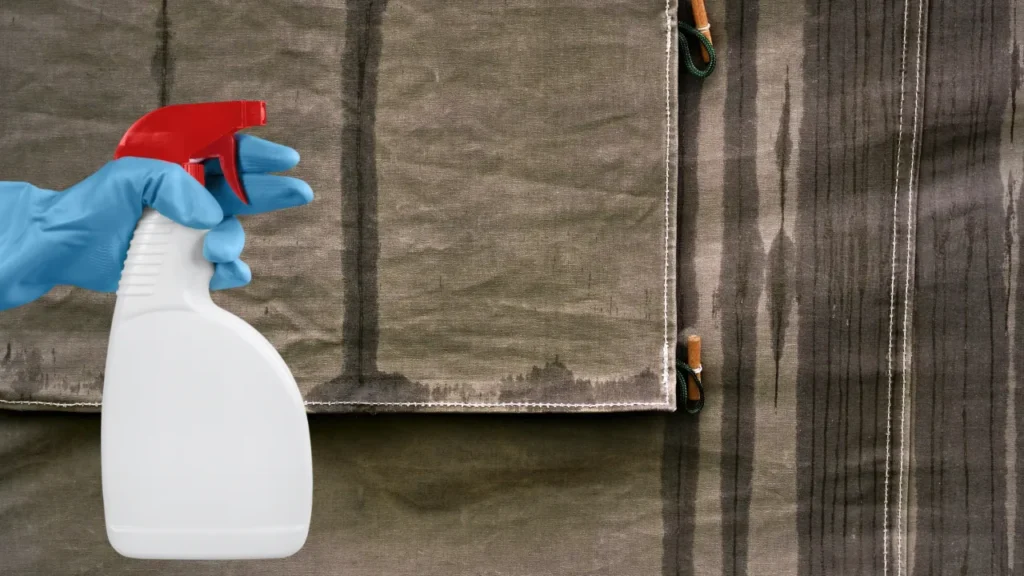
Did you know that the waterproofing on your tent can wear off over time making your tent no longer waterproof (or not as much as it once was)?
Every few years it can be a good idea to re-waterproof your tent to stop water collecting on and moving through the tent fabric.
It's pretty easy to re-waterproof your tent with some Nikwax Wash-In Waterproofing (Amazon).
This restores the waterproofing of your tent and also provides UV protection from the sun so your tent and other gear can last longer.
Restores water-repellency and revives breathability of all waterproof garments and tents. Easy wash-in application and contains no PFAS, optical brighteners, or added scent
8. Don't Dry Clothes Inside Your Tent
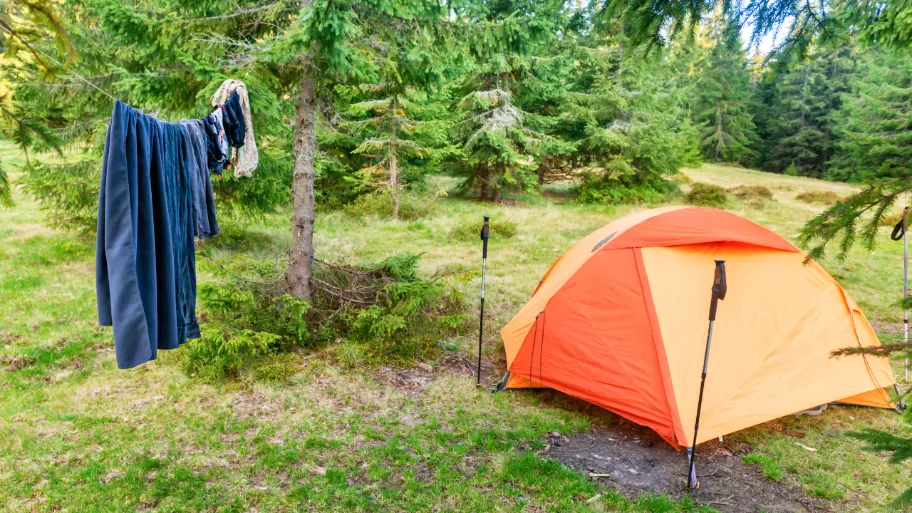
While it may be tempting to dry your clothes inside your tent (especially if it's raining) this can actually add to the water condensation inside your tent and cause your bedding and other items to become wet.
Where possible try to dry your clothes outside under cover or under a tarp rather than inside your tent.
9. Use Water-resistant Bedding
This is common for most sleeping bags, but you should make sure that your sleeping bag is somewhat water-resistant and made of synthetic material. Cotton and moisture do not mix, so you should stay away from cotton for sleeping fabrics.
“Water-resistant” with sleeping bags usually means that the outermost layer of fabric has been coated with a durable water-repellent that acts sort of like a wax finish on a car. Water droplets will bead up and prevent moisture buildup.
If your bedding is a bit aged like mine, this layer may have worn off over time. In this case, you can easily reapply the water resistance with a durable water-repellent spray like this Gear Aid Revivex Durable Water Repellent Spray from Amazon.
Reproof and restore jackets, bibs, ski pants, gloves, drysuits and waders; add water repellency to nylon tent flies, down jackets, and backpacks.
Apply Durable Water Repellent spray for all-season protection from water, dirt, and stains.
Another great tip is to NEVER unpack your sleeping bag before it’s time to go to bed and don't leave it out during the day.
I know too many people that do this, and it’s generally a bad idea because it allows moisture to seep into your bedding over the course of the day, leaving that damp feeling when it’s time to sleep.
10. Use a Sleeping Bag Liner
Camping on a summer night is like nothing else, but sleeping in a bag on hot nights can mean a lot of sweat and moisture.
This is where using a sleeping bag liner can come in handy. These are made of absorbent materials that will catch things like sweat, oil, and overall *ickiness* before they reach your bedding.
Just place your liner inside of your sleeping bag before climbing in, and you should be able to sleep more comfortably.
Keep your sleeping bag squeaky clean and say hello to a fresher, more hygienic sleep. This sleeping bag liner is ultralight and is easy to wash. Plus the integrated pillow sleeve gives you extra comfort and protection.
11. Use a Camping Cot or Sleeping Pad
Often times your bedding will accumulate moisture while camping from the walls and lining of your tent. As this Redditor says, having your bedding touching the tent will eventually bring in moisture over time.
The first thing you should do to prevent this is to have a tent large enough so that your bedding does not touch the walls while you lay in it (or arrange it accordingly).
If you want to go even further, consider using a camping cot or a sleeping pad under your sleeping bag.
A camping cot will elevate your bedding off of the ground, ensuring that moisture does not seep in through the floor.
Get yourself off the floor and sleep in comfort with a camping cot. A wide range available in different price ranges.
These can take up room, so if you’re looking to save space a sleeping pad can be a much more compact option.
Using either of these will help prevent moisture from seeping into your bedding from the walls and ground of your tent.







